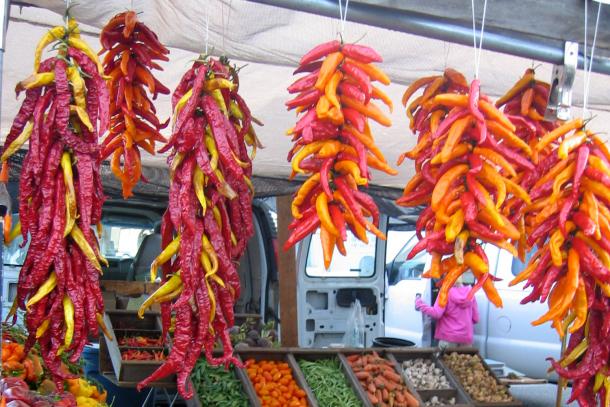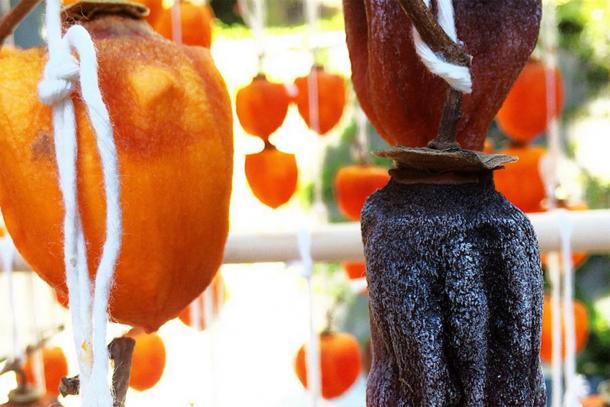Putting Up the Fall Harvest
September 29, 2017
’Cause these canned goods I buy at the store
Ain’t got the summer in them anymore.
—Greg Brown, “Canned Goods”
Fall means the end of the summer harvest, a time when people have traditionally put up the last crops of the season to ensure sustenance during the colder, less fruitful days of winter. But harvest time has lost much of its meaning in the modern age of industrial food production. Today, canned and processed foods are abundant, and peaches and tomatoes (however hard, watery, and tasteless) are available in the supermarket produce section year round.
At the farmers market, fall is felt more acutely, as we make way for winter squash, root vegetables, and citrus and say goodbye to the stars of summer. But there’s still time to capture a few of those seasonal treats through pickling, jamming, fermenting, freezing, drying, and other forms of food preservation. Putting up food yourself is a fun and rewarding way to connect with the seasonal cycles. Plus, buying produce in bulk at the farmers market means you’re supporting local farmers directly, and the produce is as ripe and fresh as it can be.
There are many online resources and books on food preservation, but in the spirit of the harvest, we thought we’d share a few simple ideas for saving some late summer and fall favorites for a cold, rainy day.
Tomatoes: Tomatoes are one of the most widely consumed vegetables (or, technically, fruits) in the United States, so their seasonal passing at the farmers market can send many of us into shock. But you don’t have to suffer through tomato withdrawal or succumb to bland imports during the cooler months. A no-fuss way to save these juicy farmers market beauties is to slow-roast them with olive oil to make a sweet, chunky, concentrated sauce, and then freeze it. Bay Area Bites has a great “lazy girl’s” guide for preserving Dirty Girl Farm’s Early Girls, which have just a few more weeks in the market. During the off-season, you can find also dried tomatoes at Everything Under the Sun and canned tomatoes at Dirty Girl Produce.

Peppers: High pepper season winds down as we get deeper into fall. There are myriad ways to bottle up some of that heat in sauces, pickles, and jams, but one of the easiest—and most beautiful—ways is by creating a chile ristra or wreath by stringing chiles together. If you’re looking for pepper products to tide you over until next summer, you’ll find hot sauces, pepper relish, chile salts, and chipotle jam at Happy Quail Farms and Tierra Vegetables.
Herbs: While fresh herbs are available year-round at the market, some popular ones, like basil, take a break in the winter months. You can dry your favorite herbs by tying the root ends together with a string and hanging them upside down in a dry, well-ventilated place. Alternatively, you can chop them up and freeze them in ice cube trays with a bit of olive oil or water. Just toss the cubes in a heated pan when you’re ready to use.
Apples: Apples are available at markets throughout the year, thanks to the wonders of modern refrigeration. So why put them up? The local apple harvest officially runs August through October, and many of those rare and delicate heirloom varieties have only a brief window and don’t make it to the cold-storage afterlife. You can save your favorite varieties by making dried apple chips or freezing homemade applesauce. At the market you’ll find fresh apples as well as sauce, cider vinegar, and hard cider at the Apple Farm, Little Apple Treats, and Hidden Star Orchards.

Persimmons: Persimmons are abundant at the market in the fall, but you may want to start preserving them before their day in the sun is up. Hachiyas (the acorn-shaped ones that are best eaten when super ripe) can be peeled and processed into a pudding-like consistency and frozen for future use. In Japan, firm Hachiyas are dried into the delicacy hoshigaki in late September and early October, and fuyus can also be dried. Everything Under the Sun and Blossom Bluff Orchards sell dried persimmon slices.
Olives: Many of us turn up our noses at salty canned black olives of the supermarket variety, but DIY olives are a whole other ballgame—and simpler to make than you might think. You can find freshly picked olives at the farmers market and create your own home-cured olives, seasoned and spiced to your liking, which will last throughout the year. Bariani Olive Oil and Knoll Farms offer fresh olives in October and November.
Hoshigaki photo by @i_heart_pizza.

